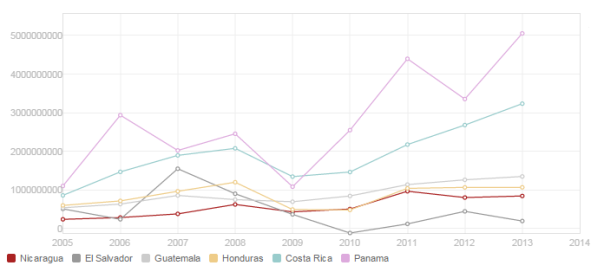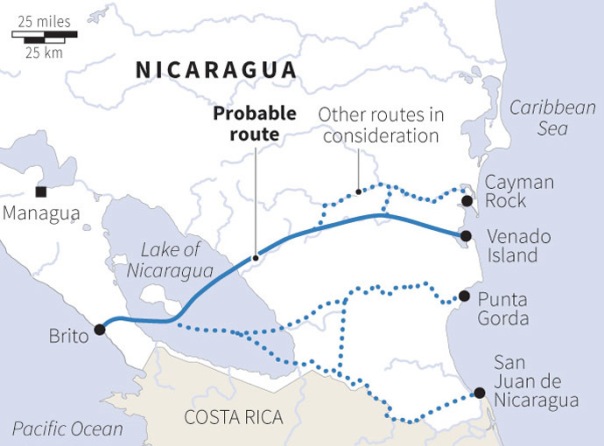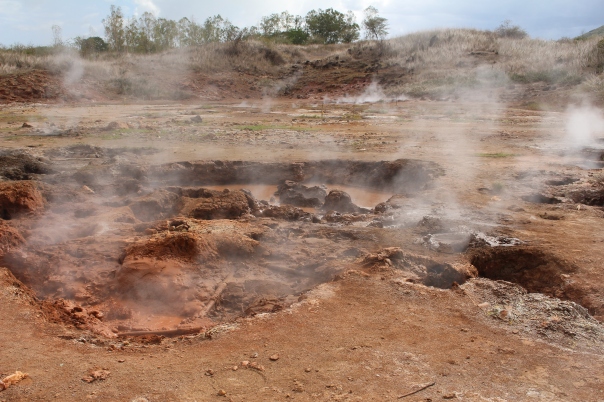This post is being cross-posted on my other blog about my life, travel, and Peace Corps service in Nicaragua, Incidents of Travel. It was written in 2015 but I delayed publishing it until I completed my service.
As a Small Business Development Volunteer, I naturally find myself asking myself questions like why Nicaragua is underdeveloped and what the source of Nicaragua’s challenges is. My journals are littered with my attempts to answer these questions. As a development volunteer, I just feel like they are necessary questions to ask in order to successfully help develop the country.
While on my trip in December I took another stab at the question and put together a list of reasons that rang true to me. I even went so far as to e-mail the list to my friend Luke who has a Master’s Degree in International Development from the London School of Economics. Luke is no expert on Nicaragua so he did not have any answers for me, but he did recommend (for the second time) that I read Why Nations Fail. So I read it.
Here is a refined version of my list:
- La Piñata. Corrupt officials steal, embezzle, and launder funds
- Party Propaganda. Corrupt officials, who want to keep hitting the piñata, use official funds for party propaganda campaigns, like the $22,000 a pop Trees of Life in Managua
- With official funds being funneled to party pet projects, there is little money left over for necessary welfare and infrastructure projects, such as roads, bridges, ports, and schools
- Lack of infrastructure and an educated workforce repels possible foreign direct investment (FDI)
- Poor quality and an underfunded health care system decreases the productivity of working age adults who suffer from acute and chronic ailments
- A poorly enforced property rights regime decreases the incentives for development of any kind
Why Nations Fail basically says that underdevelopment is a product of extractive economic institutions. Simply put, unrepresentative or autocratic governments mismanage the economy or intentionally exploit the people for the benefit of the people in charge. And unfortunately, it is basically what I see here in Nicaragua. A blog post from late last year points out Nicaragua as a development failure. Its best year of GDP growth was way back in 1976 (I actually did a quick Google search to verify, and I turned up 1974, not 1976, but either way, that’s a long time to be waiting for sustained economic growth).
As a result of Nicaragua’s perverted institutions, government efforts are directed to keeping the ruling class in power and enriching them. And the examples are all around us and numerous. First and foremost is the canal. Ortega refuses to release the details of the economic impact plan, which has everyone scratching their heads and wondering why Ortega would spend so much political capital on the canal, except to further enrich himself and his family. Furthermore, another controversial spending policy is the Trees of Life in Managua. They are towering, illuminated, steel trees that are painted yellow. They look like they are out of Dr. Seuss, and they cost upwards of $20,000 each. When my parents came and visited they even asked me what those yellow trees they saw from the airplane were. I personally believe that urban aesthetics is important and democratic governments can justly devote some of their limited funds to it, but from the news coverage I have read about the Trees of Life in Managua, it is a complete exaggeration lacking public support that only exists to further the Sandinista cause (The Trees of Life are central to a re-branding campaign for the Sandinistas that takes them away from their guerrilla roots and makes them more people-friendly). Instead of overblown canals and Trees of Life, what Nicaragua needs are investments in education, inter-model infrastructure, and energy.
Currently there are at least 94 Trees of Life in Managua. This comes at an up-front price tag of $1,880,000. Plus, each year they consume $6,075,970 in electricity (at an exchange rate of 26.77:1 Córdobas to USD). That’s a total expenditure of $7,955,970. Now, like I said, with public support I believe that urban aesthetics is beneficial and a virtuous cause, however in this case I feel that the funds could be very useful elsewhere in the national budget. A teacher in Nicaragua makes about $250 a month, or $3,000 a year. If the Trees of Life budget was completely diverted to new teachers, the country could hire approximately 2,650 more teachers. And there is certainly a teacher shortfall. One of the schools that I work with lost two teachers because they were needed at another school. Every single teacher left at the old school has a 100% full schedule. No breaks after a class with 62 kids in it. No planning periods; not to mention that the teacher that I was working with had to be re-assigned to teaching other subjects, so a lot of the work that I have put in along with my predecessor is now for naught. To me this is a prime example of the scourges of extractive political systems.
Unfortunately, I have countless other examples illustrating my frustration. In July 2014 I met a baker. He runs the bread bakery out of his and his wife’s house, and they’ve had success. They sell out of bread nearly every day. Every day he wakes up at 3:00 AM to let the first of his workers in, they fire up the oven, and they continue on like that into the afternoon. Recently, he was able to buy himself a second house, so he does not have to live in the same building that his business is in. At this point the only way he can grow the business is if he gets a bigger oven. His current oven is wood burning, and all larger models are electric (and expensive to buy as well). I recently sat down with him to see if we could come up with a financial plan to buy him the new oven, but there was one insurmountable obstacle: the price of electricity.
Electricity is expensive in Nicaragua. It is more expensive in Nicaragua than any other Central American country. And for commercial users, like bakers, the more you consume the more expensive electricity becomes. This is primarily because Nicaraguan generation and distribution infrastructure is poor, plus 75% of electricity is generated from burning oil, which is expensive and inefficient. Most of it is provided subsidized by Venezuela. I’m actually sitting here right now with my laptop plugged in wondering for how much longer the lights will stay on, since oil prices have dropped so low and Venezuela is absolutely reeling in economic chaos.
This doesn’t have to be the case. Nicaragua is endowed with an endless supply of renewable energy in geothermal form. The entire Pacific seaboard is extremely thermo-active and dotted with ominous active volcanoes. Just like Iceland, which is completely driven by renewable energy sources (70% hydroelectric and 30% geothermal), Nicaragua too could greatly reduce its dependence on Venezuelan oil by investing in geothermal electricity. El Salvador, Nicaragua’s northern neighbor, already produces 25% of its electricity through geothermal generation.
 But instead, Nicaraguans languish in promises of Grand Inter-Oceanic Canals, constant blackouts, and expensive electric bills. So expensive, in fact, that successful business owner see no possible means by which they can grow their companies. At the end of our conversation the baker decided that he would not plan to buy the new electric oven. If he did his electric bill would skyrocket, he would have to raise the price of his bread, fewer people would buy it, and he would wind up losing money on his investment. This is all not to mention that wood-burning ovens are extremely inefficient, bad for the environment, and wreak havoc on lung health.
But instead, Nicaraguans languish in promises of Grand Inter-Oceanic Canals, constant blackouts, and expensive electric bills. So expensive, in fact, that successful business owner see no possible means by which they can grow their companies. At the end of our conversation the baker decided that he would not plan to buy the new electric oven. If he did his electric bill would skyrocket, he would have to raise the price of his bread, fewer people would buy it, and he would wind up losing money on his investment. This is all not to mention that wood-burning ovens are extremely inefficient, bad for the environment, and wreak havoc on lung health.
Other examples abound. At Gigante Beach in Rivas there is a stretch of beach that is completely undeveloped. It certainly has a virgin charm, but the local community and visitors alike could benefit from some attractions, such as hotels, guesthouses, restaurants, or surf shops. Unfortunately, there is a long-standing and unresolved land ownership dispute on the beach. As a result, no one can build anything. They say that if anyone were to build anything the other two purported owners would come and burn it down.
Public land is not immune to this sort of legal entanglement and mismanagement. I work with and have met a number of tourism cooperatives that operate on public park lands. The government has left these lands abandoned, so the cooperatives manage them and charge a fee to tour operators to bring their clients. This leads to what I call an unholy trinity. The government sees the cooperative making a profit off of the land, so they demand a piece of the pie (I’ve heard up to 70%). This of course angers the cooperative because they are only filling the vacuum of the government’s mismanagement. And the tour operators complain, saying that they are being overcharged compared to the services that the cooperatives provide. And I see no resolution. If the government were to get its 70% the cooperatives would fold, and I highly doubt that the government would actually start providing the services in lieu. Then the tour operators would complain about the poor conditions of the reserves, which is what compelled the cooperatives to associate in the first place. It is an unholy trinity whose solution lies in responsible and effective public management of the lands, but extractive political institutions have no incentive for this sort of behavior. Land management policy is far more focused on preserving the status of large landowners so they can continue to reap the benefits of the land and perpetuate Sandinista power, rule, and privilege.
And therein is my frustration being a development volunteer. How can I possibly be successful if the state institutions that invite me to serve in their country have effectuated complete impediments to my work and the work of their citizens? Given that successful, nationwide international development may not truly be possible based on my current understanding of development and why nations fail, I think we need to look for new solutions.
Possible Solutions
At the macro level, when we are talking about nations, I’ve recently been hearing about an idea most popularly espoused by the economist Paul Romer: Charter Cities.
Currently, the largest and most publicized charter city project in the world is in Choluteca, Honduras, which is actually quite close to me. It is right over Nicaragua’s northern border, which I don’t live very far from. My region of Nicaragua actually has some relatively strong economic ties to Choluteca. Basically, a charter city is when a government gives a charter to a corporation to govern and develop a municipality. The idea is that, with local representation on the board, the corporation, who has an incentive to turn a profit, will establish rule of law and provide genuine economic development opportunities for its citizens.
The idea, and the actual implementation in Honduras is extremely controversial, but it appeals to me as a possible solution, or rather as an approach to tackle, the institutional problems that lie at the heart of why nations fail. However, I worry that the reasons national fail, extractive institutions, may themselves be a roadblock to charter cities, since the ruling class will not want to cede power and the economic resources they are mining as a result of their power.
Another option I have thought up is group-based development.
I came up with the thought of group-based development while I was reading Why Nations Fail. The book was written at the dawn of the Arab Spring, which dominated headlines at the beginning of 2011. But recall that later that year Occupy Wall Street was borne upon us, taking over domestic headlines for a time. The theories espoused in Why Nations Fail discuss development at the macro level – entire countries. But it does not substantively address success, or failure, of groups within nations. And since 2011 we have all been extremely focused on income inequality and its deleterious effects. Even within rich, developed nations there can still be pockets of extreme poverty. A nation can develop, but groups within it can falter or lag behind. I believe that development can be successful, if it focuses on under-developed groups, rather than under-developed nations.
In Nicaragua I can identify off of the top of my head a number of groups that we can work with. In fact, many Volunteers already work with some of these groups:
- Coffee pickers
- LGBT community
- Caribbean Coast peoples
- People with disabilities
However, group-based development does not have to work exclusively in lesser developed countries. In fact, it may be most effective in developed countries that are not victims of extractive institutions. That is to say, group-based development theoretically would work best in countries where institutions give every group the potential to develop. A Peace Corps Volunteer in the future may be very surprised to hear that she is heading to Australia to work with the Aboriginal people, a refugee camp in Turkey or Jordan, or to an Indian Reservation in South Dakota!
Now of course we have to ask ourselves why inequality exists in the first place in developed countries. Could it be that a nation is macro-inclusive, but has extractive policies aimed at certain minority groups? I believe that this could absolutely be the case, and I keep seeing the signs of it more and more in my own country, the United States. Why Nations Fail counts, I think rightly so, the United States as a developed and inclusive nation. One of the first, in fact. However, no one can deny that income inequality is relatively strong in the US and that certain groups, most prominently African Americans, find themselves on the wrong end of the GINI curve. This has its roots in slavery and share-cropping and the need for laborers to toil in cotton fields for the benefit of the plantation elite. Today, we see the vestiges of these institutions prominently in the criminal justice system and the education sector, among others. And more so, we are seeing an ever-growing influence of big money in politics, which simply allows the rich to control the political system so that our country’s institutions continue to benefit them regardless of their effect on the less wealthy and other disadvantaged groups. It is somewhat scary to see, and as I analyze my host country here, it becomes more and more apparent to me that my own country in facts suffers some of the same problems, at times even more perniciously than Nicaragua.
I’m conscious of the fact that this post has strayed far from a post purely about economics, but nevertheless I will leave it on a note about Marxist philosophy. I’ve written before about the development philosophy of the Peace Corps and how it is based on a Brazilian-Marxist education philosopher who believes that oppression can become entrenched in the psyche of not only the oppressed, but the oppressors as well. And education based in critical thinking and questioning can be used to break this cycle. I find it interesting that the in vogue theory on why nations fail at the moment is about oppressive and extractive institutions, and the Peace Corps (myself included as a Volunteer) practices a philosophy that specifically targets this issue at a grassroots level. So it leaves hope that we will not have to abandon development as we know in it in lesser developed countries, but instead shift our focus as much as possible to human development so that the people of a country can work together to change their institutions from extractive to inclusive, all for the better.
Sources:
http://www.geo-energy.org/pdf/reports/GEA_International_Market_Report_Final_May_2010.pdf
http://en.wikipedia.org/wiki/Electricity_sector_in_Nicaragua
https://www.opendemocracy.net/opensecurity/arthur-phillips/charter-cities-in-honduras
http://www.confidencial.com.ni/articulo/14289/el-derroche-de-los-039-arboles-de-la-vida-039
http://www.laprensa.com.ni/2014/08/25/nacionales/209062-millonario-gasto-de-energia-en-arboles
Incidentally, Holywood is promoting a movie that is based on a famous work of art by Gustav Klimt, an Austrian artist who inspired Chayo’s Trees of Life. Here are some of his Trees of Life works:










Leave a comment
Comments 0